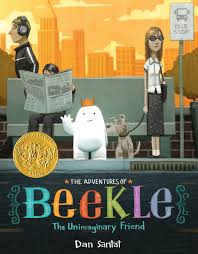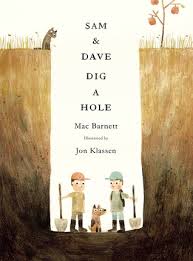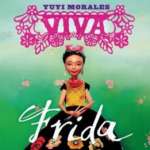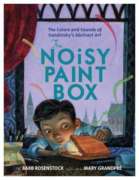The Caldecott Award Winners
by Kathleen Crawford-McKinney & Lauren Freedman
May, 2015
We chose to start with The Adventures of BEEKLE, The Unimaginary Friend because we’ve listened to our colleagues’ wonderment as to why this book became the Caldecott winner for 2015. Then we decided for this My Take/Your Take to look at an additional three honor books for 2015. These are Sam and Dave Dig a Hole, Frida, and The Noisy Paint Box: The Colors and Sounds of Kandinsky’s Abstract Art.
 The Adventures of BEEKLE, the Unimaginary Friend (TAOB) written and illustrated by Dan Santat
The Adventures of BEEKLE, the Unimaginary Friend (TAOB) written and illustrated by Dan Santat
Lauren: This is a story of awareness – of living in the now. This is a story of imagination, and permitting ourselves to participate – to imagine the way things could be – or should be. Our imagination motivates us. Without our minds, there is no imagination. Beekle cannot exist without a human and without Beekle, human lives are dull and empty.
Kathleen: This is a great book to win the Caldecott. Neither the words nor the pictures can exist on their own. They need to be together. The cartoon-like pictures can seem immature to some, but I like Beekle being bloblike because one’s imagination exists within this blob. Some of the illustrations, such as when Beekle goes off on his own to find a human, show a world where imagination exists unformed. It reminds me of Charlie and the Chocolate Factory where the illustrations are in shades of gray in the beginning.
Lauren: What Beekle sees at first is very colorless and friendless.
Kathleen: Then he realizes imagination does exist but the colors are muted again as he searches for his friend. When he meets her, the images brighten slightly but come to live when, “…they realize they were perfect together.”
Lauren: And Alice gives him her name and names him. His blush at receiving his name is very moving and shows the intimacy of friendship. In the double paged spread, the comic strip like illustrations clearly provide the text with the emotion of intimacy.
Kathleen: It’s also telling that his dog seems to acknowledge Beekle. In the picture spread, Beekle and the dog are white while everything else is in shades of gray. So the reader’s eye moves from Beekle to the dog to the other imaginary friend who leads Beekle and the reader to the world of imagination.
We encourage those naysayers to revisit Beekle and all of the imagination that occurs within the book.
 Sam & Dave Dig a Hole by Mac Barnett, Illustrated by Jon Klassen
Sam & Dave Dig a Hole by Mac Barnett, Illustrated by Jon Klassen
Lauren: I don’t get it. I think Sam and Dave look like men rather than boys and it concerns me that it doesn’t frighten them when they dig so deep that they can no longer climb out. The dog seems to both know where the spectacular stuff is and how to get out because he goes after his bone. But, what are they falling through at the end that they arrive back where they started. Maybe it is all supposed to be pretend.
Kathleen: Perseverance. I think that is the gist of this story as the boys/men come close to something “spectacular.” Just as they come so close to finding the gem, they move in a new direction; never reaching the diamond shaped deposits throughout the book. Are they looking for treasure or is it that they keep looking?
Lauren: I think they dig a hole and play… Instead of big sky at the end in a two-page spread, I would rather have seen the entire adventure depicted on a kind of timeline. So that it is clear that their “something spectacular” is the adventure itself. While this is interesting, it is too big of a leap given what is provided by the author/illustrator. In this case, the illustrations and the text are difficult to follow.
Kathleen: It seems like it was akin to The Wizard of Oz, in that the adventure is all in Dorothy/Sam & Dave’s imaginations. They never actually leave home. It’s just imagination.
Lauren: I don’t really value the illustrations as I think they are too simplistic and don’t really share Sam’s and Dave’s thinking.
Kathleen: I disagree, I think the illustrations are the humor of this story, in particular those oversized diamond that takes over one full page, and the boys never do find it. They start off in a new direction searching for that special something. I can relate to that! They are determined to keep hunting.
 Viva Frida! by Yuji Morales
Viva Frida! by Yuji Morales
Kathleen: Imagination seems to be the central thread that runs through this creative book. Both the story topic of the artist Frida Kahlo and the artistic style of Morales’ illustrations in Viva Frida! provide the reader multiple ways to get to know this artist. The illustrations are incredible beginning with the title page, which suggests the multimedia techniques. Morales captures the essence of the artist she explores including all of the images often connected with Frida, i.e., the parrots, pet monkey and wounded deer that are typically present in Frida’s artwork. I read this book multiple times and with each reading I was drawn into the illustrations and into Frida’s life. I could really imagine being among Frida’s artwork and saw her playfulness in the way the illustrations and text created an illusion of dream like sequences. As one story – each 2-page spread is a glimpse into the real life of Frida.
Lauren: Right, it is a biography; it is very real in a surreal way. The illustrations and the text are inseparable. The illustrations by themselves would be meaningless unless you knew a lot about Frida, herself. It is a chronology in a way — beginning with “I am” and ending with “I live.”
Kathleen: The way Morales used perspective in her multimedia illustrations represent Frida’s story. All of the characters in the story such as her pet monkey, parrot, dog, and even Diego Rivera are utilized to help us understand the story. Even the movement of the arrows provides the reality of danger and sorrow that lead Frida to the depth of feeling.
Lauren: We watch Frida and the pet monkey “see” (looking in the yellow box) and then we watch them “play” (playing with the artifacts in the yellow box), then she stops, to think, dream, feel, understand, love, and create, in order to live. It would be interesting to know how Yuyi Morales collaborated with the photographer, Tim O’Meara on the perspectives of the photographs.
Kathleen: Morales’ illustrations, much like the original artwork of Frida, are strangely powerful and mirror this very unique artist. This is a book that could be used with young readers – even though typically Frida’s original artwork is “not pretty” and some might think it is scary. These illustrations help a young reader enter into the work of a famous artist in a very simplistic, yet meaningful way. Young readers can read this picture book all by themselves.
Lauren: My one disappointment was the way the Spanish language was shadowed behind the English. It was very faint and light colored, while the English was dark and bold. It appears that English is privileged over the Spanish language that Frida spoke. At the end, the author provides detailed information that was important to her. She shares and highlights biographical information that resonated with her to relay the story. It is printed in both Spanish and English, with English being first unfortunately.
 The Noisy Paint Box: the colors and sounds of Kandinsky’s abstract art by Barb Rosenstock, Illustrated by Mary Grandpre
The Noisy Paint Box: the colors and sounds of Kandinsky’s abstract art by Barb Rosenstock, Illustrated by Mary Grandpre
Lauren: This book speaks to a young man and his time, and the social pressures to fit in and be productive. Children were at the mercy of the adult world’s “shoulds.” Kandinsky was obedient. But, the illustrations make clear that he was bored by the metronome. Even his auntie who gave him the paint box anticipated that he would only use it to appreciate art. No one suspected or allowed that he could hear his paint box.
Kathleen: But as soon as he received the paint box, it began to speak to him. The reader is introduced to art through the sounds of a symphony. When Kandinsky is told to paint like everyone else, he paints wilted flowers. During my first read, when I opened the book, I was disappointed because the title page was not abstract or representative of Kandinsky’s style. Instead it started off with muted colors and a sad boy until he received his paint box as a boy; that is when vibrant colors first appear. Mary Grandpré makes the clear connection between the color and the sounds Kandinsky hears. She demonstrates an amazing transaction between the Rosenstock’s text and Kandinsky’s art to create the illustrations for this biography.
Lauren: The colors are muted each time his creativity is stifled and he turns to painting flowers and houses, becomes a lawyer instead of an artist. But, once he went to the symphony and…
Kathleen: “…heard the colors singing;” “…and saw the music dancing;” he returned to his life as an artist and is credited with the beginning of abstract art as a genre. That’s when the illustrator begins to incorporate an abstract style. Because of this book, I will look at Kandinsky’s artwork much differently and try to hear his paintings.
Lauren: I enjoyed the life experience aspect of the book. The reality of Kandinsky’s growing up surrounded by very traditional adults who encouraged him to follow the rules is something most children can relate with. The illustrations clearly indicate his displeasure even as he obeys their direction. This reality shows the courage and passion that allows artists to be true to themselves and their art.
“I could hear the hiss of the colors as they mingled.” V. Kandinsky

Ray and Prisca, Thanks again for reminding us of the power of visual text and the profound affect just one color has on the meaning. I had a conversation a few minutes ago with a colleague who asked me, “At what age do kids begin to read?” When I talked about the visual text and the meaning gained from it, he was surprised. I’m going to share your My Takes with him–I suspect he will never look at picture books the same!
I am a retired teacher who consults with parents of gifted children. A partner and I co-facilitate SENG Model Parent Groups. Fine literature is always a topic! These will be on our list!